How to Grow and Care for Tamarind Trees: Expert Tips for Stunning Results
- May 14, 2024
- 0 comment
Growing tamarind trees is both rewarding and straightforward when you follow the right steps. With proper tamarind tree care tips, you can enjoy their beauty and a bountiful harvest of flavorful fruit. From choosing the best soil for tamarind trees to mastering watering and pruning techniques, this guide covers everything you need to know to ensure healthy growth and maximum yield.
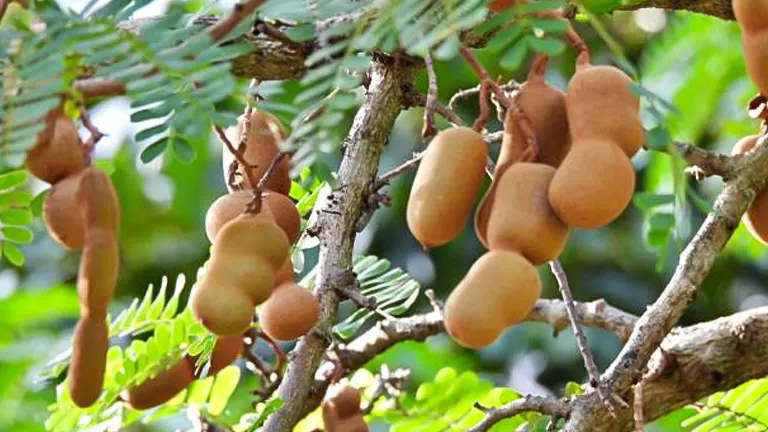
Whether you’re a seasoned gardener or just starting out, this guide will equip you with essential tamarind tree care tips and techniques for success. Learn everything from proper planting and nurturing methods to avoiding common pitfalls. With insights on the best soil for tamarind trees, watering tamarind trees effectively, and pruning tamarind trees for healthy growth, you’ll be set up for stunning results and a thriving tree.
Table of Contents
- Understanding Tamarind Trees
- Planting Tamarind Trees
- Care and Maintenance
- Common Pests and Diseases
- Harvesting and Post-Harvest Care
- Troubleshooting Common Issues
- Benefits and Uses of Tamarind
- Conclusion
- FAQs
Understanding Tamarind Trees
Origin and Botanical Characteristics
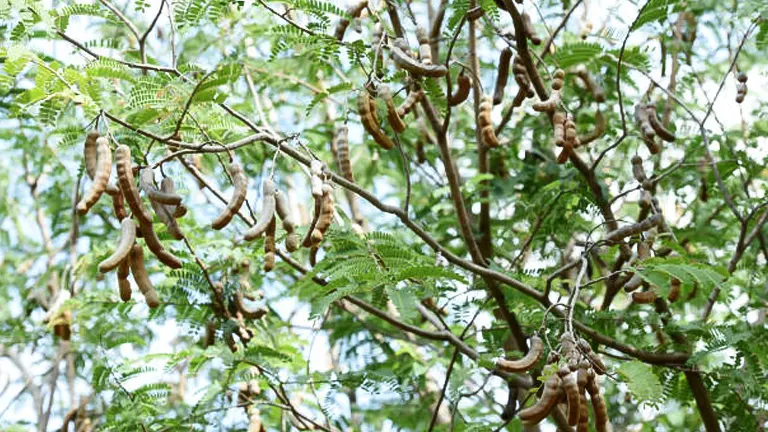
The tamarind tree (Tamarindus indica) is a tropical species originally from Africa, particularly Sudan. Over centuries, it has been cultivated widely in Asia, Latin America, and the Caribbean due to its versatility and value. Growing tamarind trees is a long-term commitment, as they are long-lived and grow at a medium pace, eventually reaching up to 82 feet (25 meters) in height. The tree boasts a dense, spreading crown and feathery, pinnate leaves made up of small, delicate leaflets. These leaves close at night or during harsh weather, showcasing the tree’s natural adaptability.
Climate and Soil Requirements
Tamarind trees thrive in tropical and subtropical climates, preferring temperatures between 77°F and 95°F (25°C to 35°C). They are remarkably adaptable, growing well in various soil types, including sandy loam and clay, as long as the soil is well-drained. For the best soil for tamarind trees, ensure it is well-drained and can handle slightly alkaline conditions, with a pH of up to 8.5. These resilient trees can also tolerate saline environments, making them suitable for diverse locations. Adequate sunlight is essential tamarind trees require full sun exposure for at least six hours daily to ensure healthy growth and fruit production.
Common Varieties of Tamarind Trees
- Sweet Tamarind: This variety is known for its sweeter fruit, making it ideal for fresh consumption. The pods are generally larger and contain less acidic pulp.
- Sour Tamarind: Primarily used for culinary purposes, this variety has a tangy flavor, which is preferred for making sauces, pastes, and traditional dishes.
- Manila Tamarind (Pithecellobium dulce): Though often confused with true tamarind, this species is distinct. It produces sweet and sour fruit and is valued for both its edible pods and ornamental appeal.
Key Characteristics and Environmental Preferences of Tamarind Trees
| Characteristic | Details |
|---|---|
| Botanical Name | Tamarindus indica |
| Native Region | Tropical Africa (Sudan) |
| Height | Up to 25 meters (82 feet) |
| Leaf Structure | Feathery, pinnate leaves |
| Fruit | Brown, pod-like, tangy pulp |
| Optimal Temperature | 25°C to 35°C (77°F to 95°F) |
| Soil Type | Well-drained sandy loam to clayey |
| pH Tolerance | 4.5 to 8.5 |
| Sunlight Requirement | Full sun (6-8 hours/day) |
| Common Varieties | Sweet, Sour, Manila Tamarind |
Unique Information
- Drought Tolerance: Tamarind trees are highly drought-tolerant once established, due to their deep root systems that can access underground water sources. However, young trees need consistent watering.
- Symbiotic Relationships: Tamarind trees often form symbiotic relationships with nitrogen-fixing bacteria in their root nodules, enhancing soil fertility and reducing the need for nitrogen fertilizers.
- Lifespan: Tamarind trees have a long lifespan, often living for over 200 years, making them a sustainable choice for long-term agricultural and horticultural projects.
Planting Tamarind Trees
Selecting the Right Location
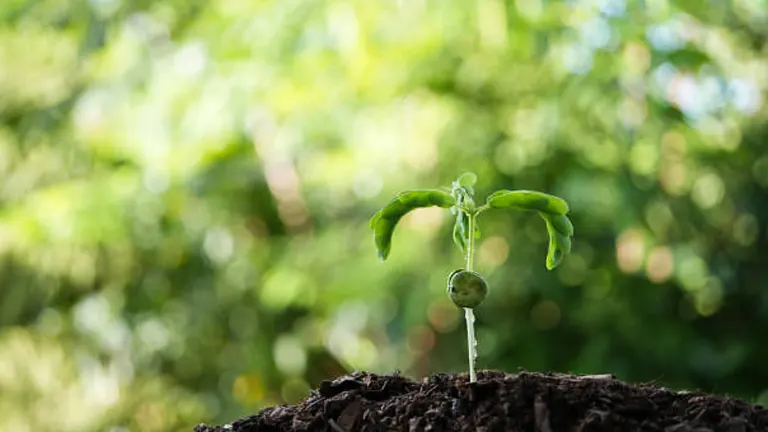
Selecting an ideal location is vital for successfully growing tamarind trees. These trees flourish in sunny environments, needing at least 6–8 hours of direct sunlight daily for healthy growth and fruit production. Ensure the soil is well-drained to prevent root rot, as tamarind trees are sensitive to waterlogging. While they can tolerate various soil types, including sandy loam and slightly alkaline or saline soils, choosing the best soil for tamarind trees well-drained and nutrient-rich will support optimal development. Avoid low-lying areas prone to standing water to minimize the risk of water-related diseases.
Spacing and Planting Distance
Proper spacing is essential to ensure that tamarind trees have enough room to grow and develop a healthy root system. The spacing varies depending on the planting density:
- Low Density: 12-15 meters between trees, 15-20 meters between rows.
- Medium Density: 8-10 meters between trees, 10-12 meters between rows.
- High Density: 4-6 meters between trees, 6-8 meters between rows.
These distances allow for adequate air circulation, sunlight penetration, and ease of maintenance, reducing the risk of disease and promoting healthy growth.
Propagation Methods
There are several methods to propagate tamarind trees, each with its own advantages:
- Growing from Seeds:
- Procedure: Soak seeds in warm water for 24 hours before planting to soften the seed coat and enhance germination. Plant the seeds in a well-draining potting mix.
- Germination: Typically occurs within two weeks. Seedlings should be transplanted to their final location when they are about 15-20 cm tall.
- Growing from Cuttings:
- Procedure: Use semi-hardwood cuttings taken in early spring. Dip the cut end in rooting hormone to promote root development and plant in a well-draining potting mix.
- Care: Keep the soil moist and provide indirect light until the cuttings establish roots.
- Grafting Techniques:
- Procedure: Graft scions from a desired variety onto rootstocks to produce uniform trees with superior fruit quality. Grafting is usually done in late winter or early spring.
- Benefits: Produces trees that bear fruit more quickly and ensures consistent fruit quality.
Step-by-Step Planting Guide
- Soil Preparation:
- Enrich the soil with organic matter such as compost or well-rotted manure to improve fertility and drainage.
- Conduct a soil test to determine pH levels and nutrient availability. Amend the soil as necessary to achieve optimal conditions (pH 6.0-7.5).
- Planting Depth:
- Dig a hole twice the width of the root ball and slightly deeper.
- Place the tree in the hole, ensuring that the root collar (where the trunk meets the roots) is level with or slightly above the soil surface.
- Backfilling and Watering:
- Backfill the hole with soil, gently firming it around the roots to eliminate air pockets.
- Water thoroughly to settle the soil and provide initial moisture for the tree.
- Mulching:
- Apply a thick layer (5-10 cm) of mulch around the base of the tree to retain moisture, regulate soil temperature, and suppress weeds. Avoid placing mulch directly against the trunk to prevent rot.
- Watering Schedule:
- Water the tree regularly, especially during dry spells. Young trees need consistent moisture to establish strong roots, while mature trees are more drought-tolerant.
Factors for Successful Tamarind Tree Planting
| Factor | Details |
|---|---|
| Sunlight Requirement | Full sun (6-8 hours/day) |
| Soil pH Range | 6.0-7.5 |
| Watering Frequency | Regular watering for young trees; drought-tolerant when mature |
| Optimal Temperature Range | 25°C to 35°C (77°F to 95°F) |
| Spacing (Low Density) | 12-15 meters between trees, 15-20 meters between rows |
| Spacing (Medium Density) | 8-10 meters between trees, 10-12 meters between rows |
| Spacing (High Density) | 4-6 meters between trees, 6-8 meters between rows |
| Propagation Methods | Seeds, cuttings, grafting |
Unique Information
- Drought Tolerance: Tamarind trees, once established, are highly drought-tolerant due to their deep root systems that tap into underground water reserves.
- Symbiotic Relationships: Tamarind trees form symbiotic relationships with nitrogen-fixing bacteria, which enhance soil fertility and reduce the need for additional nitrogen fertilizers.
- Lifespan: Tamarind trees have a long lifespan, often living for over 200 years, making them a sustainable choice for long-term agricultural and horticultural projects.
- Wind Resistance: Tamarind trees have strong wood and a deep root system, making them resistant to wind damage and ideal for planting in areas prone to storms.
Care and Maintenance
Watering

Proper watering is essential for the growth and health of tamarind trees, especially during their early stages. Here’s how to manage their watering needs effectively:
- Young Trees: Consistent watering is crucial to help young tamarind trees establish a strong root system. Water deeply once or twice a week, ensuring the soil is moist but not waterlogged. Deep watering encourages roots to grow deeper into the soil, enhancing the tree’s stability and drought resistance.
- Mature Trees: Once established, tamarind trees are quite drought-tolerant. However, they still benefit from occasional deep watering during prolonged dry periods to maintain health and productivity. Watering every 2-4 weeks during dry spells can help support fruit development and overall tree vigor.
Scientific Insight:
- Water Requirement for Young Trees: Approximately 25-30 liters per tree per week.
- Water Requirement for Mature Trees: 40-60 liters per tree per month during dry periods.
Fertilization
Fertilizing tamarind trees correctly ensures they receive the necessary nutrients for robust growth and fruit production. Here’s an effective fertilization strategy:
- Balanced Fertilizer: Apply a balanced fertilizer with equal parts nitrogen (N), phosphorus (P), and potassium (K) during the growing season. This ensures that the trees receive all the essential nutrients for healthy growth.
- Organic Fertilizers: Incorporate organic matter such as compost or well-rotted manure to improve soil structure, increase nutrient availability, and enhance microbial activity.
Fertilization Schedule:
- Early Spring: Apply a balanced NPK fertilizer to support new growth.
- Mid-Summer: Reapply the balanced fertilizer to sustain growth and fruit development.
- Early Fall: A final application helps prepare the tree for the winter and supports root development.
Scientific Insight:
- NPK Ratio: 10-10-10 or 15-15-15
- Application Rate: 0.5-1 kg per tree per application
Pruning and Training
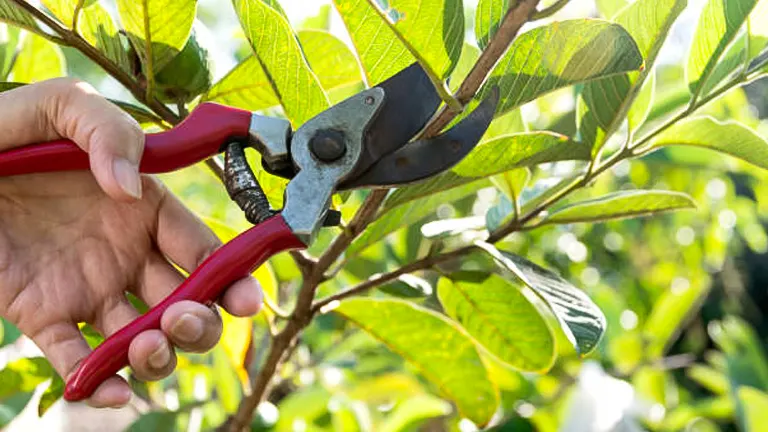
Pruning and training are vital for maintaining the health, shape, and productivity of tamarind trees. Proper pruning encourages strong structure, improves light penetration, and enhances air circulation.
- Formative Pruning: Conduct formative pruning during the first three years to shape young trees. Remove crossing branches and maintain a single leader (main stem) to establish a strong framework.
- Maintenance Pruning: Annually remove dead, diseased, or damaged branches. Thin the canopy to allow light and air to penetrate, reducing the risk of fungal diseases.
- Rejuvenation Pruning: For older trees, cut back up to one-third of the tree to stimulate new growth and improve productivity. This type of pruning is usually done every 3-5 years.
Scientific Insight:
- Optimal Pruning Time: Late winter or early spring, before the growing season begins.
- Pruning Tools: Use clean, sharp pruning shears to make precise cuts and prevent disease spread.
Care and Maintenance Requirements for Tamarind Trees
| Care Aspect | Young Trees | Mature Trees |
|---|---|---|
| Watering | 25-30 liters per week | 40-60 liters per month (dry periods) |
| Fertilization | Balanced NPK (10-10-10 or 15-15-15) | Balanced NPK (10-10-10 or 15-15-15) |
| Formative Pruning | Remove crossing branches, single leader | Not applicable |
| Maintenance Pruning | Annually, remove dead/diseased branches | Annually, remove dead/diseased branches |
| Rejuvenation Pruning | Not applicable | Cut back up to one-third every 3-5 years |
Unique Information
- Mulching: Applying mulch around the base of tamarind trees helps retain soil moisture, suppress weeds, and regulate soil temperature. Use organic mulches such as straw, wood chips, or compost, and apply a 5-10 cm thick layer, keeping it away from the trunk to prevent rot.
- Pest and Disease Monitoring: Regularly inspect tamarind trees for signs of pests or diseases. Early detection and management are crucial to prevent significant damage. Common pests include aphids, scales, and fruit borers, while common diseases include powdery mildew and root rot.
- Nutrient Deficiencies: Monitor for signs of nutrient deficiencies, such as yellowing leaves (nitrogen deficiency) or poor fruit set (phosphorus deficiency). Adjust fertilization practices accordingly to address these issues.
Common Pests and Diseases
Identifying Pests
- Red Palm Weevil (Rhynchophorus ferrugineus): These large, reddish-brown weevils bore into the trunks of tamarind trees, causing significant internal damage. Early signs include holes in the trunk and oozing sap. Use pheromone traps and apply insecticides like imidacloprid for control.
- Date Palm Scale (Parlatoria blanchardi): Small, immobile insects that attach to the fronds, causing yellowing and weakening of the tree. Apply horticultural oils or systemic insecticides like acetamiprid to manage infestations.
Identifying Diseases
- Bayoud Disease (Fusarium oxysporum f. sp. albedinis): This fungal infection causes fronds to wilt and die back, eventually killing the tree. Remove and destroy infected parts and apply fungicides like benomyl to prevent spread.
- Fusarium Wilt (Fusarium oxysporum f. sp. canariensis): Characterized by yellowing and wilting of fronds, starting from the older, lower leaves. Use resistant varieties and apply systemic fungicides such as thiophanate-methyl.
Harvesting and Post-Harvest Care
When to Harvest
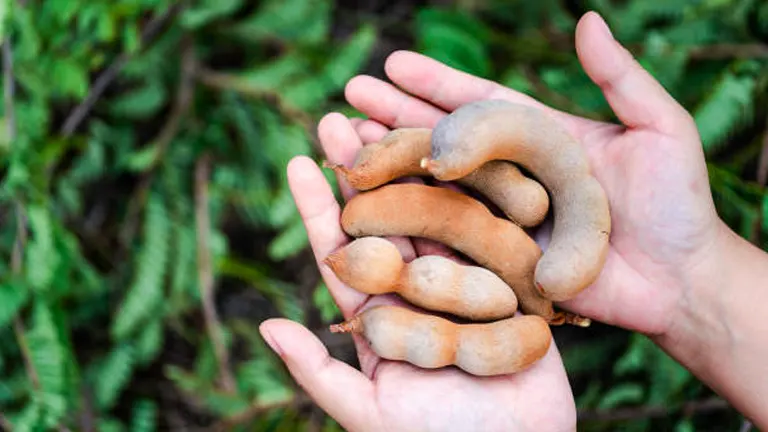
Harvesting tamarind at the right time is crucial to ensure the best quality and flavor. Here’s how to determine the optimal harvest time:
- Maturity Indicators: Tamarind fruits are ready for harvest when the pods are fully developed, brown, and brittle. The pulp inside should be sticky and slightly dry, indicating ripeness.
- Season: In most tropical regions, tamarind harvesting typically occurs between late winter and early spring. The exact timing can vary based on local climate conditions and tree variety.
Scientific Insight:
- Optimal Harvest Time: Late winter to early spring
- Maturity Signs: Pods should measure about 12-15 cm in length, with a moisture content in the pulp around 20-25%.
Harvesting Techniques
Proper harvesting techniques are essential to minimize damage to the tree and the fruit. Here are the best practices:
- Tools: Use a long-handled pruning tool or a sharp knife to cut the pods from the tree gently. This prevents damage to the branches and allows for safe harvesting from tall trees.
- Handling: Handle the pods carefully to prevent bruising, which can affect the quality and shelf life of the fruit. Place the harvested pods in shallow baskets or trays to avoid stacking and crushing.
Scientific Insight:
- Tools Used: Long-handled pruning shears or sharp knives
- Harvesting Method: Cut pods at their base, avoiding pulling or twisting to reduce branch damage
Post-Harvest Processing
Once harvested, tamarind pods need to be processed properly to ensure they retain their quality and extend their shelf life.
- Cleaning:
- Remove any debris, such as leaves or twigs, from the pods.
- Gently wash the pods to remove dirt and impurities. Ensure they are dried thoroughly after washing to prevent mold growth.
- Drying:
- Spread the pods in a single layer in a well-ventilated area.
- Allow them to dry naturally in the sun for 5-7 days, or use a dehydrator set at 40-50°C (104-122°F) for more controlled drying.
- Proper drying ensures the pulp remains slightly sticky while reducing moisture content to around 15-20%.
- Storage:
- Store dried tamarind pods in a cool, dry place, ideally in airtight containers to protect them from humidity and pests.
- Proper storage can extend the shelf life of tamarind pods for up to a year without significant loss of quality.
Scientific Insight:
- Drying Temperature: 40-50°C (104-122°F)
- Moisture Content for Storage: 15-20%
- Shelf Life: Up to 12 months when stored in optimal conditions
Key Steps in Harvesting and Post-Harvest Care
| Step | Details |
|---|---|
| When to Harvest | Late winter to early spring; pods brown and brittle |
| Harvesting Tools | Long-handled pruning shears, sharp knives |
| Handling | Handle gently to avoid bruising |
| Cleaning | Remove debris, wash and dry thoroughly |
| Drying | Sun-dry for 5-7 days or use dehydrator at 40-50°C |
| Storage | Airtight containers in cool, dry place; shelf life up to 1 year |
Troubleshooting Common Issues
Nutrient Deficiencies
- Nitrogen Deficiency: Yellowing of older leaves, stunted growth. Apply a nitrogen-rich fertilizer.
- Phosphorus Deficiency: Dark green foliage, delayed fruiting. Use phosphorus supplements.
- Potassium Deficiency: Browning of leaf edges, poor fruit quality. Apply potassium-rich fertilizers.
Environmental Stress
- Drought: Provide deep watering during prolonged dry periods.
- Frost: Protect young trees with frost blankets during cold snaps.
Benefits and Uses of Tamarind
Nutritional and Health Benefits
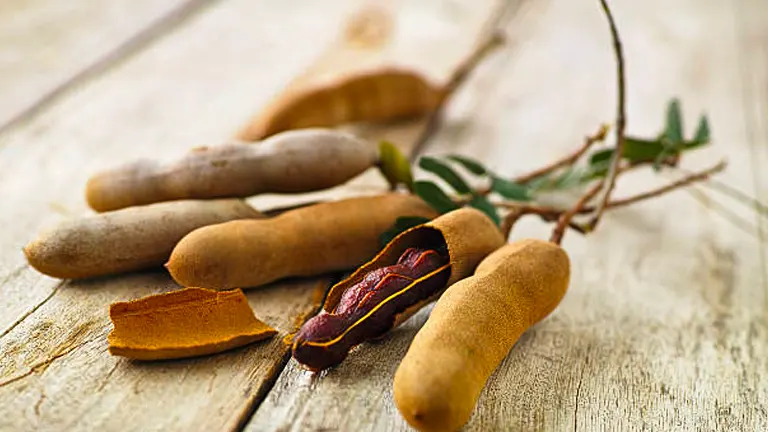
Tamarind is rich in vitamins, minerals, and antioxidants. It aids in digestion, supports heart health, and has anti-inflammatory properties.
Culinary Uses
Tamarind is a popular ingredient in many cuisines, used in sauces, soups, and desserts. Its tangy flavor enhances the taste of various dishes.
Other Uses
- Medicinal Uses: Tamarind is used in traditional medicine for its laxative, antipyretic, and antimicrobial properties.
- Industrial Applications: Tamarind pulp is used in the food industry, while the seeds are processed for their starch content.
Related Post
- How to Fertilize Bougainvillea: A Complete Guide for Stunning Blooms
- How to Fertilize Apple Trees: Essential Tips for a Bountiful Harvest
- How to Fertilize Lemon Trees: Secrets for Thriving Citrus
- How to Fertilize Avocado Tree: A Step-by-Step Guide for Lush Growth
Conclusion
Growing and caring for tamarind trees is a fulfilling endeavor that combines beauty and utility. By applying the right tamarind tree care tips from proper planting and maintenance to effective pest management you can ensure your trees grow healthily and produce a bountiful harvest of high-quality fruit. With the right location, the best soil for tamarind trees, and regular care, these trees can reward you with shade, beauty, and delicious fruit for years to come.
FAQs
- Can tamarind trees be grown in containers?
Yes, tamarind trees can be grown in large containers, especially during their early stages. Use a well-draining potting mix and ensure the container has adequate drainage holes. Regularly transplant to larger containers as the tree grows to prevent root-bound conditions. - How long does it take for a tamarind tree to bear fruit?
Tamarind trees typically start bearing fruit after 6-8 years when grown from seeds. Trees propagated through grafting or cuttings may start producing fruit as early as 3-4 years. The exact timeline can vary based on growing conditions and tree care. - What are the best companion plants for tamarind trees?
Companion plants that thrive under similar conditions as tamarind include papaya, mango, and citrus trees. These plants enjoy similar sunlight and soil requirements and can help create a diverse and resilient garden ecosystem. - How can I protect my tamarind tree from strong winds?
Protect young tamarind trees from strong winds by installing windbreaks or planting them near protective structures. As the tree matures, its sturdy trunk and root system will help it withstand wind better. Staking young trees can also provide additional support. - Is it necessary to hand-pollinate tamarind flowers for better fruit production?
Hand-pollination is not typically necessary for tamarind trees, as they are usually pollinated by wind and insects. However, in areas with limited pollinator activity, gently shaking the branches during flowering can help improve pollination and fruit set. - How often should I prune my tamarind tree?
Pruning should be done annually to maintain the tree’s health and shape. Formative pruning during the first three years helps establish a strong structure, while maintenance pruning removes dead or diseased branches and thins the canopy to improve air circulation. - Can tamarind trees tolerate salty soil or water?
Tamarind trees are relatively tolerant of saline conditions, making them suitable for coastal regions. However, it’s essential to provide regular freshwater irrigation to prevent salt buildup in the soil, which can affect overall tree health and productivity. - What are the signs of overwatering a tamarind tree, and how can I correct it?
Signs of overwatering include yellowing leaves, root rot, and a soggy, waterlogged soil surface. To correct overwatering, reduce the frequency of watering, improve soil drainage by adding organic matter, and ensure the planting area is well-drained to allow excess water to escape.
By following these expert tips, you’ll be well on your way to growing healthy and productive tamarind trees. Enjoy the beauty and bounty that these unique trees bring to your garden.

Benjamin Brooks
Forestry AuthorGreetings! I'm Benjamin Brooks, and my journey over the past 15 years has revolved around the fascinating realms of content creation, expertise in snow clearing, and the intricate world of lumberjacking and landscaping. What began as a simple curiosity about the natural world and heavy machinery has evolved into a passionate profession where my love for crafting words intertwines seamlessly with my lumberjacking and garden skills.













Leave your comment